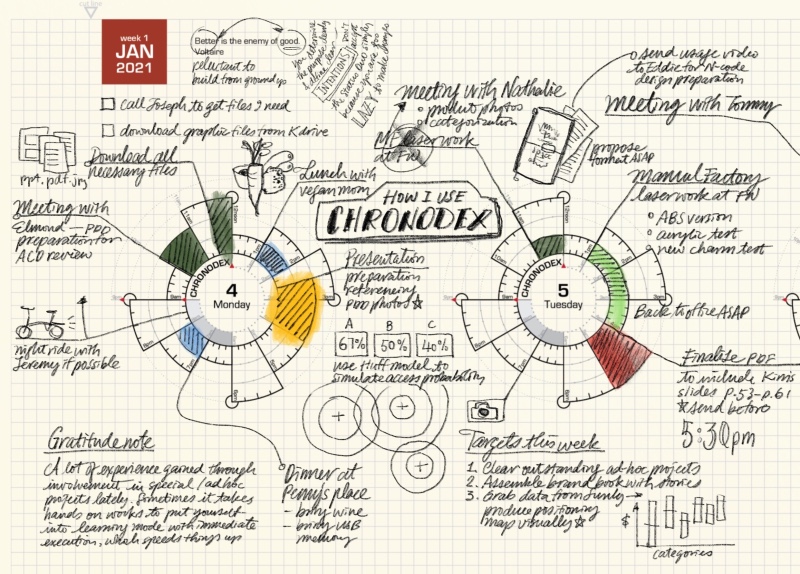As I’ve been struggling with planning ever since I received a cancer diagnosis in mid 2021, I’ve been reflecting on the many planner systems that I’ve used over the years. Most of these systems didn’t stand the test of time for me, but I think that there’s still something to learn from their failure. So while I’m working out how planning looks like for the new, post-cancer treatment me, I thought that I would write down my reflections on each system that I have used.

I love planning, I’ve always loved planning, and together with many analogue systems I have tried quite a few to do apps over the years. Analogue planning systems, while sometimes cumbersome, always worked better for me, which is why that’s what I’ll focus on in this short series of posts.
I first discovered Chronodex, Patrick Ng’s gorgeously visual planning system, when he first published it in late 2011. It immediately appealed to me because it was so visual, and I’m a visual thinker, and it was so very different from anything else that was going around in the planning world at the time. This was well before the days of various bullet journal tracking pages, in the heady days of GTD and the Fountain Pen Network. The Rhodia Webnotebook was new and exciting stuff, and the Traveler’s Notebook was all the rage.
Patrick’s Chronodex was meant to be printed at home, 6 months of planning pages at a time, and then folded and cut to size to fit a Traveler’s Notebook. I tried to do that at first, and failed miserably. Home printers are terrible, and the result was unusable and just a waste of a lot of paper and inkjet ink.
Since I still really wanted to give the system a try, I went to the office supply store next to my job and bought a circle template ruler. Using that, a Rhodia Webbie and a Pilot Hi Tec C Coleto I created hand drawn Chronodex pages for a few months. I was a team lead at the time, I was overwhelmed with work and meetings, and I thought that visual time blocking as offered by the Chronodex would be the solution.
I really insisted on getting the Chronodex system to work for me, because I was so aesthetically enamoured with it. I pushed it until it broke and then I kept dragging it on for weeks before I finally realised that it was time to move on. The Chronodex wasn’t for me.
The system works on time-blocking, as drawn on a circular 12 or 24 hour template that is supposed to mimic a watch face. If you are a visual thinker you will immediately see the appeal. If you like pretty planner pages, you will also love the Chronodex’s elegant beauty. But planning for me has first and foremost got to work on a practical level, and the system faired poorly there.
If you have relatively few things to do throughout the day, or if your day is already time blocked (i.e. you are a student or a teacher) then the Chronodex could work well for you.
If, on the other hand, you have a lot going on, or you tend to have to jump around between tasks, or if your days aren’t so easily well defined in time blocks, then the Chronodex is likely not for you. It becomes too cluttered to be readable if you try to splice your day into small time blocks, and if your day is fluid and not well defined in advance, you aren’t going to be able to to time block it until you start to actually do the thing. The Chronodex isn’t a Pomodoro substitute, it’s the equivalent of having an old-school day planner with the hours marked on it, and chunking out your work and meetings in advance in your planner. It’s a great system for students, and for people who have a high degree of control and certainty about their day.
What I did take from Chronodex is the option to stop and visually time block my day when things are getting out of hand in terms of my expectations versus what I can actually do in the time at hand.
If you are at all curious about the system, I encourage you to visit Patrick’s beautiful site and maybe print out a page or two to try it out. Another option is to draw out the Chronodex circles yourselves, just to see if there’s anything in the system for you (don’t do it long term, though, as it takes ages). A third option is to go Etsy and search for Chronodex. There are dozens of stamps for sale with the Chronodex template on them.
Daphna Kedmi
I’m from the generation that started off with no computers, with analogue planning on paper, and became immediately enamored with Office and it’s planning and task system. It seemed to be the answer to all our planner dreams. Old School!
LikeLike
writingatlarge
There’s a lot of value in digital planning systems and calendars, especially for repetitive tasks and shared planning. But I still think better and faster on paper.
LikeLike
Pingback: Ghosts of Planners Past: Weekly Planners – Writing at Large
Pingback: Ghosts of Planners Past: Filofax – Writing at Large
pentabit
Funny – I did not know about the word “chronodex”, but I recently created a free iOS app which offers a pretty cool widget which shows your events in real time on an analogue dial. I guess you can call this chronodex in action. 😉
https://apps.apple.com/de/app/week-plan-calendar/id1621397141?l=en-GB
LikeLiked by 1 person